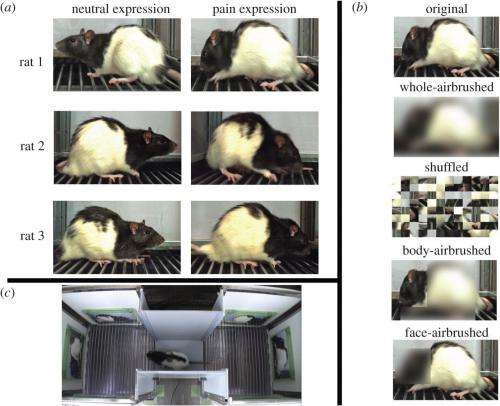April 1, 2015 report
Rats found able to recognize pain in other rat faces

(Phys.org)—A team of researchers working in Japan with affiliations to several institutions in that country, has found that lab rats are able to recognize pain in the faces of other rats and avoid them when given the opportunity. In their paper published in Royal Society Open Science, the team describes experiments they carried out with rats and what they learned by doing so.
Prior research has shown that both rats and mice display unique facial characteristics when undergoing pain—they flatten their face, squint their eyes, move their whiskers and puff out their cheeks and nose. Scientists have even created rodent pain charts that allow us humans to gauge the amount of pain a rodent is in, simply by looking at its face. In this new research, the team sought to learn whether the same is true for other rats.
To find out, the researchers took photographs of rats, both face and whole body shots while they were feeling neutral, and others while the rats were given an electric shock to the foot—they also photo-shopped some of the photos to cause blurring of different body parts. Then, they created a special cage for a group of test rats that had never been used for any kinds of experiments before. The cage had multiple "rooms" each decorated with the photographs they had taken. One room, for example, had photos of rats in pain, another had rats with neutral faces. The rooms were all interconnected so that the rats could choose where to spend their time. After dropping rats one by one into the cage and noting their behavior (timing how much time they spent where) the researchers found that the rats spent the least amount of time in the room with unblurred full face and body shots of rats in pain and spent the most time in the rooms with walls adored with neutral faced rats. This, the researchers claim, shows that the rats were able to recognize the pain in the faces of the other rats and avoided them.
The research by the team appears to answer the question of whether rodent grimacing due to pain is merely a physical reaction, or if it is meant as a sign of communication to other rats. Like humans and chimpanzees, it appears that the facial expressions serve both purposes.
More information: Receiving of emotional signal of pain from conspecifics in laboratory rats, Royal Society Open Science, DOI: 10.1098/rsos.140381
Abstract
Though recent studies have shown that rodents express emotions with their face, whether emotional expression in rodents has a communicative function between conspecifics is still unclear. Here, we demonstrate the ability of visual recognition of emotional expressions in laboratory rats. We found that Long-Evans rats avoid images of pain expressions of conspecifics but not those of neutral expressions. The results indicate that rats use visual emotional signals from conspecifics to adjust their behaviour in an environment to avoid a potentially dangerous place. Therefore, emotional expression in rodents, rather than just a mere 'expression' of emotional states, might have a communicative function.
Journal information: Royal Society Open Science
© 2015 Phys.org


















